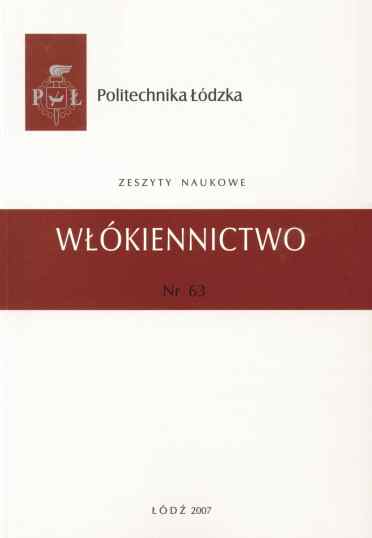Abstract
The aim of the present study was to develop spinning conditions of various multifunctional alginate fibres designed for miscellaneous medical application. Based on the tests of the basie spinning parameters (as-spun dra w ratio and deformation during the drawing stage ), optimal conditions were selected for the production of alginie acid fibers, in which the use of acid groups of the fiberformingmateriał makes it possible to incorporate an antibiotic of a new generation with graduał release capabilities. The degree of acid group substitution as well as the absorption properties and strength characteristics of the obtained fibers were determined. During the spinning stage, Distreptase was incorporated into the alginie acid fibers that are soluble (chaniging into gel) in the medium of wound.
The optimization of the fiber-spinning process intended to obtain increased fiber strength has resulted in the selection of manufacturing conditions for zinc alginate fibers with antibacterial properties designed for wounds in a subsequent stage of healing. There was also developed a process for the manufacture of precursor fibers from calcium alginate containing silica nanoparticles. It has been found that the incorporation of silica nanoparticles in an amount of 3% allows one to obtain fibers with a tenacity of 20 cN/tex. Owing to the presence of calcium and silicon in the precursor fibers, the resultant carbon fibers will support the bone reconstruction process.
The effect of basie spinning parameters on the porous structure, sorption properties and strength characteristics of fibers from copper alginate was assessed. It has been found that the fibers formed under optimal conditions show high moisture absorption and electro-conductive properties.
For all the alginate fibers obtained under optimal conditions there was performed a comparative analysis of the effect of polymer chemical structure on the supermolecular structure of the fibers determined by the WAXS method) and their moisture absorption, tenacity as well as electric and thermal properties. lt has been found that all the fibers are characterized by high sorption properties, which at a low total pore volume is connected mainly with the hydrophilic character of the fiber-forming materiał. The electro-conductivity and accompanying polarization processes are also dependent on the chemicalstructure of the fiber-forming matter. Antibacterial properties of all types of alginate fibers were determined on the bassis of the stunting zone of bacterial
growth, while in the case of alginie acid fibers, the release rate of the incorporated antibiotic was determined.
The textile processing of individual types of fibers was assessed byperforming weaving and knitting tests.
All the types of obtained alginate fibers show features of multi-functional fibers that predispose them for thep medical applications in question.
References
Tokura S., Tamura H., Tsuruta Y .: International Conference Science Medtex'99, 10-11.05.1999 r. Łódź, materiały konferencyjne pt: "Otrzymywanie włókien alginianowych zawierających fosforylochitynę jako koagulat krwi" - Wydział Inżynierii, Uniwersytet Kansei i HRC, Suita.
Berek D., Dressler M., Kubin M., Marcinka K.: Chromatografia żelowa, PWN, Warszawa (1989).
Przygocki W.: Metody fizyczne badan polimerów, PWN, Warszawa (1990).
Ferguson J., Kembłowski Z.: Reologia stosowana płynów, Wydawnictwo Marcus S.C., Łódź (1995).
Kembłowski Z.: Reometria płynów nienewtonowskich, WNT Warszawa 1973.
Mikołajczyk T.: Water-solube alginate fibres for medical applications, Fibres&Textiles in Estern Europe 9(3), 20, (2001).
Mikołajczyk T., Wołowska-Czapnik D.: Multifunctional alginate fibres with antibacterial properties - Fibres&Textiles in Estern Europe 3(51 ), 13(2005).
Mikołajczyk T., Wołowska-Czapnik D., Boguń M.: Precursor alginate fibres containing na no-particles of Si02, Fibres&Textiles in Estern Europe 3(47), 12, (2004).
Haibang L., Soonhong Y., Byungchul S.: Resing composition having biodegradability and high absorbency, nonwoven fabric made of the same and pads comprising said fabric United States Patent no 5, 166, 231.
Lipp-Symonowicz B.: Fizyko-chemiczne aspekty procesu barwienia i rozjaśniania optycznego włókien, Łódź 2003.
PN-91/P.-04871 „Textilies. Determination of the electrical resistivity".
Mikołajczyk T., Urbaniak-Domagała W., Wołowska-Czapnik D.: Effects of thestructure of polymer and nanosilica additive on the sorption and electric properties of various alginate fibers, J Appl Polym Sci 101; 686-694, (2006).
Janowska G., Mikołajczyk T., Thermal J.: Anal. Cal 71 (2003) 549.
Janowska G., Mikołajczyk T., Thermal J.: Anal. Cal. 63 (2001) 815.
Janowska G., Thermal J.: Anal. Cal 53 (1998) 309.
Janowska G., Mikołajczyk T., Wołowska-Czapnik D., Boguń M.: Effekt of the fibre-forming materiał structure and silica nanopartcles on the thermal properties of alginate fibres, Journal of thermal and calorimetry (79) 2005.
Rosenbrock H., Story C.: Computational Technigues for Chemical Engineers, Pergamon Press (1966).
Hindeleh A.M., Johnson D.J.: Journal Phys. D: Appl. Phys. 4,(259), (1971).
Marshall W.F., Blair J.E.: Cephalosporis Mayo Clinic Proceedings 74, (187-95, 1999.
JIS L 1902:2002 „Badanie działania antybakteryjnego wyrobów włókienniczych. Test ilościowy".
Stodolak E., Czajkowska B., Błażewicz M., Mikołajczyk T., Wołowska Czapnik D.: In vitro behavior of PP-PVDF PTFE Terpolymer modified with alginate fibres, Inżynieria Biomateriałów nr 38-43, (2004).

